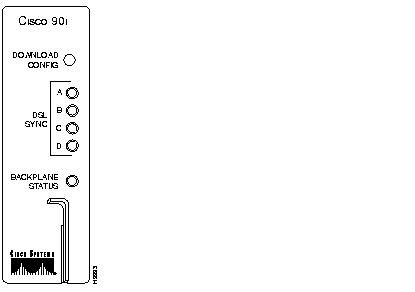|
|
Cisco 90 series DSL access products support the rapid, low-cost deployment of high-speed DSL services to residential, SOHO (Small Office/Home Office), and telecommuter end users. Leveraging the existing equipment infrastructure in telecommunications company central offices (CO) to provide an affordable solution, the Cisco 90 series products have the throughput to deliver advanced Internet and corporate intranet applications such as remote corporate access, Internet "push" technology, and local Web-site hosting to service subscribers. The Cisco 90 series includes the Cisco 90i IDSL Channel Unit and Cisco 90 Series DSL Management Agent products. The Cisco 90i IDSL Channel Unit is shown in Figure 10-118.
The Cisco 90i IDSL (ISDN Digital Subscriber Line) Channel Unit is a channel unit for use with the D4 channel banks used in virtually all North American telecommunication company central offices. Originally a TDM (time-division multiplexing) chassis used to deliver services such as traditional ISDN, the D4 is transformed by the Cisco 90i IDSL Channel Unit into a high-performance, frame relay multiplexer. IDSL provides an alternative to Digital Data Service (DDS) or fractional T1 for cost-effective dedicated Internet or intranet access at line rates of 56, 64, 128, and 144 kilobits per second over a single pair of copper wires. In addition, using IDSL, service providers can off-load subscriber data traffic from existing voice networks, reducing capacity problems on public switched telephony networks. Figure 10-119 shows a typical deployment configuration of the Cisco 90i IDSL Channel Unit within a service provider network.
The rack-mountable Cisco 90 Series DSL Management Agent facilitates carrier-class management applications and provides a standards-based, SNMP solution for service providers to monitor, configure, test, and provision services for all installed Cisco IDSL channel units. Two Cisco 90 Series DSL Management Agents can be used for redundancy, minimizing the chances of a loss of management access in case a single unit fails. No channel unit information will be lost nor will subscriber service be impacted in the case of a management agent failure.


Table 10-98 lists the specifications for the Cisco 90i IDSL Channel Unit. Table 10-99 lists the specifications for the Cisco 90 Series Management Agent.
| Description | Specification |
|---|---|
| Dimensions (HxWxD) | 4.5 x 1.375 x 10.0 in. (standard D4 channel unit) |
| Weight | 20 ounces |
| Temperature | 0 to 70°C |
| Humidity | < 95% noncondensing |
| Power Dissipation | < 2.0W (allows entire bank to be filled) |
| EMI | Meets FCC Part 15, Class A |
| Input Protection | Meets UL 1459, second edition and Bellcore TR-NWT-001089 |
| NEBS | Meets Bellcore TR-NWT-000063 |
| D4 Compatibility | Compatible with any D4 channel bank conforming to the AT&T D4 channel bank backplane specification |
| Subscriber ports | 4 |
| Port speeds | 56/64/128/144 kilobits per second (configurable) |
| Protocols | PPP (RFC-1973) and Frame Relay |
| PPP Sessions (per port) | 1 |
| Frame Relay PVCs (per port) | 8 |
| ISDN CPE Communications | Compatible with ISDN CPE that supports leased-line mode |
| LMI | Annex D |
| Description | Specification |
|---|---|
| Dimensions (HxWxD) | 7.0 x 19.9 x 19.0 in. |
| Weight | 21 lb (9.53 kg) |
| Power Requirements | 90 to 135 VAC1, 47 to 63 Hz, 2.5A
180 to 270 VAC, 47 to 63 Hz, 1.25A |
| Hardware Specifications | 19 in. rack-mount enclosure
10/100baseT Ethernet V.35 WAN interface (DB-25) |
The Cisco 90 series products provide the following features and advantages:
The Cisco 90i IDSL Channel Unit creates a low cost of ownership for customers in many ways, including:
The Cisco 90 Series DSL Management Agent is connected to the service network via a frame relay port to communicate with the channel units. This provides a very flexible solution because the agent can be connected anywhere on the network and does not need to be co-located with the channel units in the CO transmission area. The Management Agent can then be connected to a local LAN and communicate with any standard SNMP management application or service provider Operational Support System (OSS). The Management Agent also supports a redundant agent configuration to prevent a loss of management access to the network if an agent should fail.
The Cisco 90i IDSL Channel Unit conforms to the standards shown in Table 10-100.
| Specification | Description |
|---|---|
| T1.601-1992 | ISDN Basic Access Interface for Use on Metallic Loops |
| ANSI T1.617 | Signaling Specifications for Frame Relay Bearer Service |
| ANSI T1.618 | Core Aspects of Frame Relay Protocol for Use with Frame Relay Service |
| ANSI T1.606 | Frame Relay Bearer Service--Architecture Framework and Service Description |
| RFC-1661 | Point-to-Point Protocol (PPP) |
| RFC-1973 | PPP over Frame Relay |
| TR-NWT-000063 | New Equipment Building Standards (NEBS) |
| TR-NWT-000829 | Generic Operations Interfaces--Embedded Operations Channels |
| TR-NWT-001089 | Electromagnetic Compatibility and Electrical Safety Generic Criteria for Network Telecommunication Equipment |
The Cisco 90 Series DSL Management Agent conforms to the standards shown in Table 10-101.
| Specification | Description |
|---|---|
| RFC-1155 | Structure and Identification of Management Information for TCP/IP-based Internets |
| RFC-1157 | A Simple Network Management Protocol (SNMP) |
| TR-NWT-000829 | Generic Operations Interfaces--Embedded Operations Channels (SNMP MIB objects) |
The Cisco 90i IDSL Channel Unit and the Cisco 90 Series DSL Management Agent ship with all necessary hardware, cabling, and software. There are no options.
The Cisco 90i IDSL Channel Unit and the Cisco 90 Series DSL Management Agent ship with all necessary hardware, cabling, and software. There are no options.
Table 10-102 lists the Cisco 90 series product numbers.
| Description | Product Number |
|---|---|
| Cisco 90i IDSL Channel Unit | CISCO90I |
| Cisco 90 Series DSL Management Agent | CISCO90-AGENT |
|
|